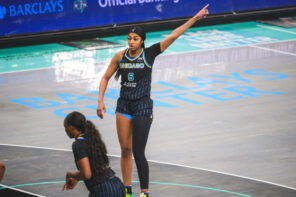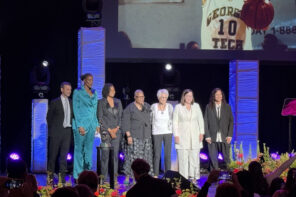The WNBA currently stands as a twelve-team league. New York City, Los Angeles, Chicago, Washington, D.C., Dallas, Atlanta, Connecticut, Phoenix, Seattle, Indianapolis, San Antonio, and Minneapolis all are homes to WNBA teams.
The topic of expansion has not been one that has risen—at least not in mainstream circles even if it may be one that could be mentioned behind closed doors.
Expansion was a topic that was on the mind of the previous league president, Laurel Richie. At 20 years old and 12 teams, one wonders if the e-word is still on the brains at Fifth Avenue in New York under current president Lisa Borders.
Borders answered this in her State of the League press conference at the WNBA Finals. She said that expansion is something that is always on the minds of WNBA/NBA brass, but said that she wants to ensure that all 12 current franchises are financially stable before expansion becomes reality.
What I do not want to do is have a spike in growth and then a crash, and so we will take our time. There’s no rush. We’ve got 12 extraordinary teams, 144 of the best athletes in the world. Expanding too fast could change all of that dynamic. And so we will, in fact, expand, but operationally sound, financially stable, incremental, sustainable growth is what we’ll be looking for before we do that.
–WNBA President Lisa Borders
On the surface, there are plenty of worthy candidates for a team should interest arise. Boston is one. Philadelphia is another.
The San Francisco Bay Area is another.
San Francisco-Oakland-San Jose currently stands as the largest media market sans a WNBA team. And, of course, the rise of Silicon Valley as an international technology hub has made the Bay Area an even more attractive market than it already was.
Recently, the topic of a WNBA team in the Bay Area was brought up in an editorial that was published in the East Bay Times. It was published not too long after Team USA’s showing the Olympics that saw them win a sixth consecutive gold medal.
That article received the attention of many a Bay Area resident—including Jennifer Smith, the CEO of the Bay Area Women’s Sports Initiative.
I think, really, the idea of bringing girls to professional sporting events when you see people like themselves competing for that idea of ‘If I can see her, I can be her’.
–Jennifer Smith said to Beyond The W.
Smith coached for eight years in girls youth soccer and also was a three-sport athlete in high school as she took part in field hockey, track and soccer. She played soccer collegiately at the Division I level for Cornell University. Smith is part of Cornell University’s Athletics Hall of Fame.
It also received the attention of Anne Cribbs, a former Olympian and co-founder of the first women’s professional basketball league in the United States—the American Basketball League, which was based in the Bay Area. She also led San Francisco’s 2012 Olympic bid.
One of the teams that played in the ABL was in San Jose—the San Jose Lasers. She also believes the thought of a WNBA team somewhere in the area makes sense.
I think people probably are ready to welcome a WNBA team.
–Cribbs said to Beyond The W.
Smith made the point that having a women’s sports franchise in the Bay Area would allow young girls interested in athletics to see individuals they could look up to without being restricted to the confines of only supporting men’s professional teams.
For all of them, it’s really, really important that they can look up and see somebody playing sports that is a woman, who is making a living and able to play it at the highest level.
One point raised in the East Bay Times piece was how a WNBA team in the Bay Area would have a positive effect on the daughters of the Golden State Warriors’ Stephen Curry.
I think he would want his daughters to be able to look up and say, ‘Yes, if that’s what I want to do, I could do it.
–Jennifer Smith
The Warriors may be involved if there would be an effort to make the Bay Area the site of the WNBA’s 13th franchise. During last year’s State of the League Address prior to the All-Star Game at the Mohegan Sun Arena in Connecticut, Richie mentioned that Warriors owners Joe Lacob and Peter Guber were interested in owning a WNBA franchise.
The Los Angeles Sparks were once rumored to be heading north to the Bay before they were bought out by an investment group headed by Magic Johnson.
Oakland has Oracle Arena, the Warriors’ current arena, and San Jose has the SAP Center—where the NHL’s San Jose Sharks play. San Francisco is also in the process of building a new arena for the Warriors who intend to move out of the Oracle Arena and into the new Chase Center in San Francisco’s Mission Bay for the start of the 2019-20 NBA season.
This means that all three anchor cities for the Bay Area either have basketball-ready arenas or are in the process of building basketball-ready arenas.
Cribbs believes that while the 2016-17 Warriors team, as well as the new Chase Center are higher on the to-do list for Golden State management that women’s basketball is something on the brains of Warriors brass.
I’m not so sure that a WNBA team is right up there at the top of their list, but I know that management is interested in women’s basketball. That’s my observation.
She does believe that, arenawise, a team would be better served by playing in a stadium that seats about under 10,000 people instead of a venue like Oracle Arena with a capacity near 20,000 or Chase Center which will seat 18,000.
I think…the best size right now for women’s basketball is about 5,000 to 8,000 where you really can sell out and create an atmosphere of excitement…rather than having to curtain the upstairs of an arena and having a lot of empty seats.
Not only that, the Warriors have emerged as one of the premier franchises in the NBA. They already have Curry and added Kevin Durant in free agency. Golden State also completed a new radio deal with KGMZ-FM 95.7 The Game after a longtime radio partnership with KNBR. And, did we mention the support they receive from Silicon Valley?
There is no doubt the Warriors are making money—but will any of those additional greenbacks be put into a WNBA franchise? Smith believes that there has to be a commitment from Warriors brass, and that a business case can be made, but that there has to be a commitment from the women’s sports community to make it work.
A lot of people continue to run to the men’s sports, even when we have these great female athletes right in our backyard.
Cribbs also believes the women athletes should be able to play basketball the exact same period as the men do in the NBA. The ABL’s two full seasons both ran concurrent to the NBA schedule in late Winter into early Spring.
I continue to think it’s really tough to get the public to shift their thinking from a summer sport to having basketball be a summer sport. I’m sort of old school about that and think that basketball needs to be played during basketball season.
She mentioned how the ABL has modeled after Major League Soccer which has since transitioned into more of an ownership structure. Cribbs also talked about how players that were part of the league still have great memories of the league.
Our players, who were in the original early days, still speak very fondly of the ABL—really wanted it to continue because they wanted to play during basketball season.
Another entity Smith believes could further the case for a team in the Bay Area is USA Basketball. The United States Women’s National Team is coming off of its sixth consecutive gold medal win in Rio, and she believes that if USA Basketball did more to capitalize on these successful showings that it could only help expansion efforts.
When the U.S. Women’s (Soccer) National Team finishes up with a World Cup or gold medal, they already have booked on their schedule this nationwide tour of teams and exhibition matches. They continue the fervor.
A strong element of the case for putting a team in either San Francisco, Oakland, or San Jose is the presence of Stanford University—the alma mater of both Ogwumike sisters, Nneka and Chiney. Layshia Clarendon, Brittany Boyd, and Reshanda Grey are also WNBA players that came out of Cal.
We have such phenomenal collegiate women’s sports around this area, but when it comes to professional events, we are all taking our daughters to watch men play,
–Jennifer Smith
Not only are parents typically bringing their daughters to watch men’s sports as opposed to women’s sports, but Smith also made a point to note of one glaring challenge women’s sports are facing—support from women.
As an organization, BAWSI tries to tell people to put your money where your mouth is. Be a season ticket holder. Bring your daughters. Bring your nieces. Bring your granddaughters. Bring them out because if we don’t support it ourselves, it’s not going to happen.
Cribbs says she is unsure as to why women’s sports has this issue in getting women through the turnstiles and into the seats for women’s sports, but mentioned possible factors.
It may be a time thing, it may be the obligations that women have, it may be having not as much disposable income, it may just not having the culture. Like the guys buy the [San Francisco] Giants tickets and they go down to the closest bar, and it’s a big social event while they divvy them up.
In the case of the Bay Area itself, another challenge presents itself in the size of its market. With three anchor cities, there is no shortage of options for leisurely activities—the presence of which can be a double-edged sword, as Cribbs pointed out.
That’s a good thing and it also could be a bad thing.
Smith believes that now is as good a time as ever to place a franchise in the Bay Area, particularly given how it leads in many other cases of progressive advancement.
It’s really past time. We’ve been without a women’s professional franchise for too long. And we need one. It’s past time.
Cribbs believes that a culture change which could put women’s sports on equal footing with men—as well as increasing the overall amount of women’s professional teams and leagues is deliberately on the horizon.
It’s coming. It just is a little slow for some of us [chuckles]. >





